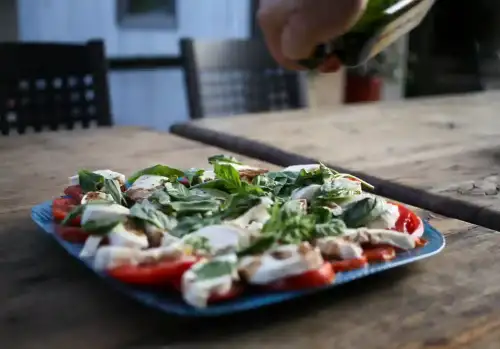Celiac.com 08/06/2025 - In the shadow of Mount Vesuvius, Naples gave birth to the Neapolitan pizza—a culinary treasure defined by its thin, soft crust, bright tomato sauce, creamy mozzarella, and minimalist elegance. Traditionally cooked in wood-fired ovens and made with wheat-based dough that develops blistered air pockets from high-heat baking, the Neapolitan pie has long been a symbol of rustic Italian simplicity and artistry. But for those with celiac disease or gluten sensitivity, this beloved dish has often remained just out of reach—until now.
This gluten-free take on the Neapolitan classic embraces everything that makes the original so special: a tangy, slightly chewy crust, rich San Marzano tomato sauce, and milky mozzarella, all finished with fresh basil and golden extra virgin olive oil. What makes this version stand out is the fermented depth of a homemade sourdough starter made from brown rice flour. Combined with tapioca starch for stretch and sorghum flour for body, the result is a crust with real character and texture, worthy of its Neapolitan heritage.
Ingredients
Celiac.com Sponsor (A12):
For the gluten-free sourdough starter (prepare 5–7 days in advance):
- ½ cup brown rice flour
- ¼ cup filtered water
- Additional brown rice flour and water for feeding daily
For the crust:
- 1 cup active gluten-free brown rice sourdough starter
- ½ cup warm water
- 1 cup sorghum flour
- ¾ cup tapioca starch
- 1 tablespoon olive oil
- ½ teaspoon fine sea salt
- ½ teaspoon psyllium husk powder (optional, for added elasticity)
For the toppings:
- ¾ cup San Marzano tomato sauce (crushed tomatoes with a pinch of salt)
- 4 oz fresh mozzarella, torn or sliced
- A handful of fresh basil leaves
- Extra virgin olive oil for drizzling
- Optional: pinch of sea salt and crushed red pepper flakes
Instructions
Step 1: Create the sourdough starter
- In a clean jar, mix ½ cup brown rice flour with ¼ cup filtered water. Stir until no dry bits remain. Cover loosely and let sit at room temperature.
- Feed the starter once every 24 hours by discarding half and adding fresh brown rice flour and water (same ratio). After 5–7 days, it should become bubbly, slightly sour-smelling, and active enough to use.
Step 2: Make the dough
- In a large mixing bowl, combine the active starter with warm water, sorghum flour, and tapioca starch. Add olive oil, salt, and psyllium husk powder if using.
- Mix thoroughly until a soft, sticky dough forms. Cover and let rise in a warm spot for 4–6 hours, or until visibly puffy and slightly increased in volume.
Step 3: Shape and pre-bake
- Preheat your oven to 475°F (245°C). If using a pizza stone or steel, place it in the oven while it heats.
- On a sheet of parchment paper, lightly dusted with tapioca starch, gently stretch the dough into a 10–12-inch circle about ¼ inch thick. Use wet hands to smooth edges if needed.
- Slide the dough (with parchment) onto a preheated baking sheet or stone. Bake for 8 minutes to set the crust.
Step 4: Add toppings and finish baking
- Remove the crust from the oven. Spread a thin layer of San Marzano tomato sauce over the surface, leaving a small border.
- Distribute mozzarella evenly and return to the oven for another 6–8 minutes, or until the cheese is melted and beginning to brown slightly.
- Optionally, broil on high for 1 minute to get golden spots on the cheese.
Step 5: Garnish and serve
- Remove the pizza from the oven, add fresh basil leaves, and drizzle with olive oil.
- Let cool slightly before slicing and serving.
Conclusion
This Neapolitan-style pizza proves that going gluten-free doesn’t mean giving up on taste, tradition, or texture. By incorporating a naturally fermented sourdough starter and thoughtfully balancing gluten-free flours, the crust holds its own—chewy, tangy, and full of character. Topped simply and classically with San Marzano tomatoes, fresh mozzarella, and basil, each slice offers the rustic joy of Naples with none of the gluten. Whether you’re hosting pizza night or craving a solo culinary escape, this pizza brings authentic Italian soul to your gluten-free lifestyle.











Recommended Comments
There are no comments to display.
Create an account or sign in to comment
You need to be a member in order to leave a comment
Create an account
Sign up for a new account in our community. It's easy!
Register a new accountSign in
Already have an account? Sign in here.
Sign In Now